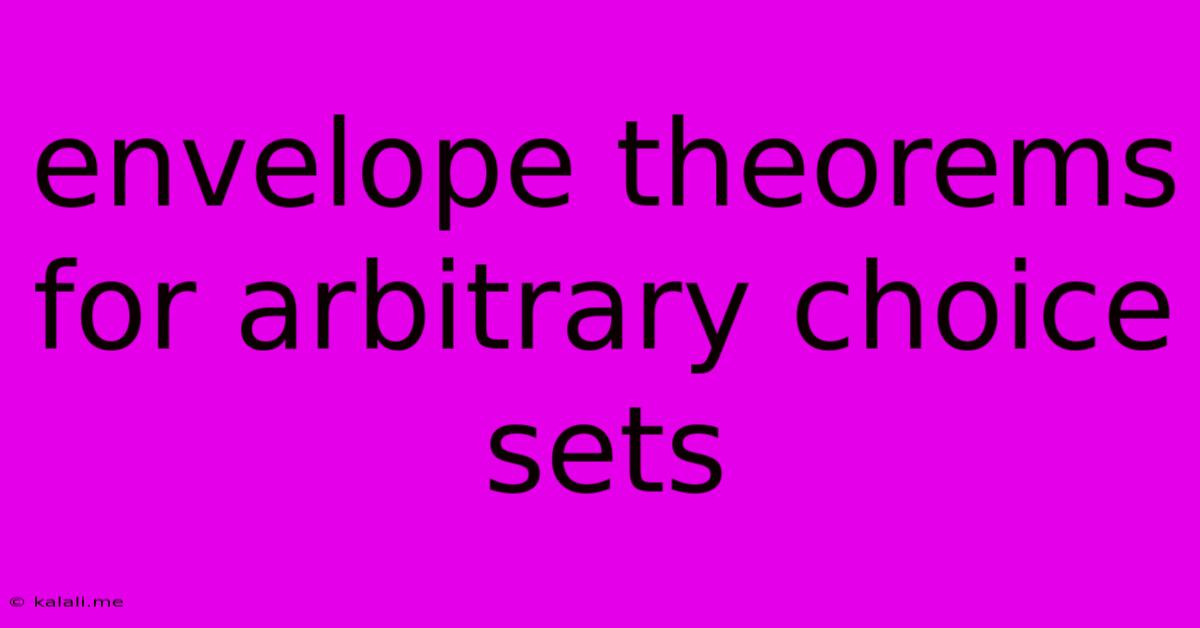Envelope Theorems For Arbitrary Choice Sets
Kalali
Jun 07, 2025 · 3 min read

Table of Contents
Envelope Theorems for Arbitrary Choice Sets: A Comprehensive Guide
Meta Description: This article explores envelope theorems, extending their application beyond standard differentiable settings to encompass arbitrary choice sets. We'll examine the fundamental concepts, provide intuitive explanations, and discuss their implications for economic modeling.
Envelope theorems are powerful tools in economics, providing a shortcut to calculating the derivative of a value function with respect to a parameter. Traditionally, these theorems rely on the assumption of differentiability and convexity of the choice set. However, many real-world economic problems involve non-convexities, discrete choices, or other complexities that violate these assumptions. This article extends the understanding of envelope theorems to encompass arbitrary choice sets, providing a more robust and widely applicable framework.
Understanding the Traditional Envelope Theorem
Before delving into generalizations, let's briefly review the standard envelope theorem. Consider a problem where an agent maximizes a function f(x, θ) subject to a constraint g(x, θ) = 0, where x is the choice variable and θ is a parameter. The value function, V(θ), represents the maximized value of f(x, θ) given θ. The traditional envelope theorem states that under certain regularity conditions (e.g., differentiability and constraint qualification), the derivative of the value function with respect to the parameter is given by:
∂V(θ)/∂θ = ∂f(x*(θ), θ)/∂θ
where x(θ) is the optimal choice of x as a function of θ. This simplifies the calculation significantly, as we don't need to explicitly solve for the optimal x and then differentiate. Instead, we directly differentiate the objective function with respect to the parameter, holding the optimal choice constant.
Extending the Envelope Theorem to Arbitrary Choice Sets
The limitations of the traditional approach become apparent when dealing with situations like:
- Non-convex choice sets: In many real-world scenarios, the feasible set of choices is not convex. For example, consider an investment problem with indivisible assets.
- Discrete choices: When the choice variable is discrete (e.g., choosing between different projects), the differentiability assumption breaks down.
- Set-valued choice correspondence: Instead of a single optimal choice, there might be a set of optimal choices for a given parameter.
To address these limitations, we need to generalize the concept of the envelope theorem. Instead of relying on differentiability, we can utilize the concept of superdifferentials and subdifferentials from convex analysis. These concepts extend the notion of derivatives to non-differentiable functions.
For a value function V(θ) that is not necessarily differentiable, we can use the following generalization:
- Subdifferential: If V(θ) is concave, the subdifferential at θ is the set of all subgradients, which provide lower bounds on the directional derivative of V(θ).
- Superdifferential: If V(θ) is convex, the superdifferential at θ is the set of all supergradients, providing upper bounds on the directional derivative.
These concepts allow us to analyze the sensitivity of the value function to changes in the parameter, even when the value function is not differentiable. The generalized envelope theorem essentially states that the subdifferential (or superdifferential) of the value function contains information about the partial derivative of the objective function with respect to the parameter, evaluated at the optimal choice.
Implications and Applications
This generalized framework significantly broadens the applicability of envelope theorems. It enables analysis of:
- Optimal control problems with non-convex state spaces.
- Discrete choice models, allowing for the analysis of the impact of parameter changes on welfare.
- Game-theoretic settings with non-convex strategy spaces.
- Models incorporating uncertainty with non-differentiable utility functions.
By utilizing subdifferentials and superdifferentials, economists can leverage the power of envelope theorems in a much wider range of economic models, leading to more accurate and nuanced analyses of various economic phenomena. Further research continues to explore the boundaries and applications of this generalized approach, pushing the frontiers of economic modeling and analysis. This broader application allows for a more realistic and robust representation of economic behavior, moving beyond the limitations of traditional differentiable assumptions.
Latest Posts
Latest Posts
-
Can You Bake In Aluminum Pans
Jun 08, 2025
-
Substitute For Instant Mashed Potato Flakes
Jun 08, 2025
-
Dan Brown Books Made Into Movies
Jun 08, 2025
-
Replace Copper Water Line To Fridge
Jun 08, 2025
-
Support To Deal With Nasus Slow
Jun 08, 2025
Related Post
Thank you for visiting our website which covers about Envelope Theorems For Arbitrary Choice Sets . We hope the information provided has been useful to you. Feel free to contact us if you have any questions or need further assistance. See you next time and don't miss to bookmark.